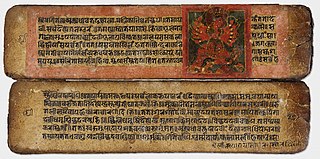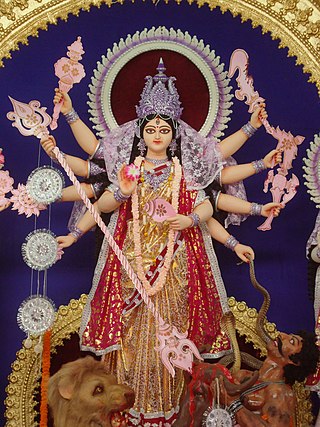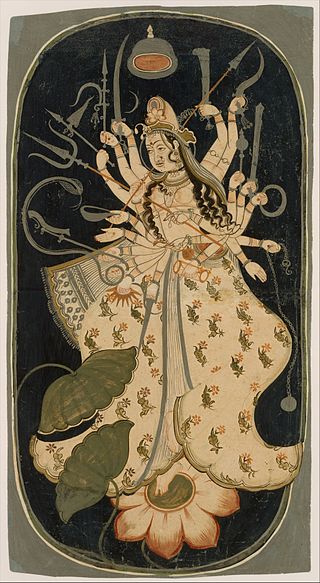
Hari is among the primary epithets of the Hindu preserver deity Vishnu, meaning 'the one who takes away' (sins). It refers to the one who removes darkness and illusion, the one who removes all obstacles to spiritual progress.

Lakshmi also known as Shri, is one of the principal goddesses in Hinduism. She is the goddess of wealth, fortune, power, beauty, fertility and prosperity, and associated with Maya ("Illusion"). Along with Parvati and Saraswati, she forms the Tridevi of Hindu goddesses.

Avatar is a concept within Hinduism that in Sanskrit literally means 'descent'. It signifies the material appearance or incarnation of a powerful deity, or spirit on Earth. The relative verb to "alight, to make one's appearance" is sometimes used to refer to any guru or revered human being.
Stotra is a Sanskrit word that means "ode, eulogy or a hymn of praise." It is a literary genre of Indian religious texts designed to be melodically sung, in contrast to a shastra which is composed to be recited.

The Devi Mahatmya or Devi Mahatmyam is a Hindu philosophical text describing the Goddess, known as Mahadevi or Adishakti, as the supreme power and creator of the universe. It is part of the Markandeya Purana.
Sahasranāma is a Sanskrit term which means "a thousand names". It is also a genre of stotra literature, usually found as a title of the text named after a deity, such as Vishnu Sahasranāma, wherein the deity is remembered by 1,000 names, attributes or epithets.

The Lakshmi Stuti is a Hindu hymn written in praise of Lakshmi, the Hindu goddess of wealth and prosperity. According to the Puranas as well as Vaishnava tradition, the authorship of this hymn is attributed to Indra, the king of the devas. It is widely used in the popular worship of the goddess and also invoked during vratas (vows).

Lakshmi Narasimha Temple, also referred to as Lakshminarasimha temple of Bhadravati, is a 13th-century Hindu temple dedicated to Vishnu, built by the Hoysala ruler Vira Someshwara. It is located in Bhadravati, Shimoga District of Karnataka state, India. The temple opens to the east and has three sanctums, one each dedicated to Venogopala, Lakshminarasimha and Vishnu-Puroshottama. It is notable for its Vesara architecture, with artwork that includes legends and deities of Vaishnavism, as well as those of Shaivism, Shaktism and Vedic deities. Important reliefs include those of Ganesha, Dakshinamurti, Bhairava, Sarasvati, Brahma, Surya, Harihara, and others. The temple's original shikaras were ruined, and have been restored with a conical structure. According to Adam Hardy – a scholar of Indian temple architecture, this temple has two "exceptional" stellate structures highlighting the architectural sophistication of the Hoysalas.

A kuladevata, also known as a kuladaivaṃ, is an ancestral tutelary deity in Hinduism and Jainism.

Subramanya is a village located in Kadaba Taluk in Dakshina Kannada, India. The Kukke Subrahmanya Temple is located here. It is about 105 kilometres (65 mi) from Mangalore, connected by train and road. It was originally named "Kukke Pattana".

Sri Sharadamba Temple is a famous Hindu temple dedicated to goddess Sharadamba in the holy town of Sringeri in Karnataka, India.

Over the years, there have been many philosophers, writers and other literary figures who have contributed to the Dvaita school of thought, founded by Sri Madhvacharya.

The Vayu Stuti is a stuti (eulogy) composed by Trivikrama Panditacharya addressed to Madhvacharya, the founder of the Dvaita school of philosophy. The hymn praises Madhvacharya as the third incarnation of the god of the wind, Vayu, after Hanuman and Bhima, a belief held by members of the Madhva tradition.

Vidyabhushana (1952-) is a vocalist from Karnataka. He sings devotional songs, chiefly Haridasa compositions, and carnatic classical music. He has many albums to his credit, mainly devotional songs in Kannada, Tulu and has given concerts all over the world. His first album was titled "Dasara Padagalu" and the 100th titled "Tanu Ninnadu Jivana Ninnadu". Performing for more than 40 years, he has traveled to many countries including a tour across the United States in 1999., He was honoured with the title of Sangeetha Vidya Nidhi in 1994. He was also honoured the Doctorate by Hampi University.

The Biraja Temple, or Birija Kshetra, is a historic Hindu temple located in Jajpur, Odisha, India. The present temple was built during the 13th century. The principal idol is Devi Durga, who is worshipped as Viraja (Girija), and the temple gave Jajpur the nicknames "Viraja Kshetra" and "Biraja Peetha". The Durga idol has two hands (dwibhuja), spearing the chest of Mahishasura with one hand and pulling his tail with the other. One of her feet is on a lion, and the other is on Mahishasura's chest. Mahishasura is depicted as a water buffalo. The idol's crown features Ganesha, a crescent moon and a lingam. The temple covers a large area, and has several shrines to Shiva and other deities. According to the Skanda Purana it cleanses pilgrims, and it is called the Viraja or the Biraja kshetra. Jajpur is believed to have about one crore of Shiva lingams.

Shakti is the fundamental cosmic energy and a central deity within Shaktism, a significant theological tradition of Hinduism. Representing dynamic forces that permeate the universe, Shakti embodies feminine energy and is often depicted as the consort of Shiva. In this tradition, Devi, the Goddess, is regarded as the Supreme Brahman herself, with all other divine forms seen as her manifestations. The worship of Shakti entails a diverse array of goddesses, including Durga, Kali, Parvati, and Tripura Sundari, each representing unique facets of her power.

Mahadevi, also referred to as Adi Parashakti, Mahamaya and Devi, is the supreme goddess in various sects of Hinduism. According to the goddess-centric sect Shaktism, all Hindu gods and goddesses are considered to be manifestations of the goddess, who is comparable to the deities Shiva and Vishnu as Para Brahman. Mahadevi as the Mulaprakriti is described having five primary forms—Durga, Lakshmi, Sarasvati, Gayatri and Radha—collectively referred to as Panchaprakriti. All other goddesses are regarded as her Amshavatara or partial incarnations.
Puttur Narasimha Nayak is a Kannada and Konkani singer and vocalist from Karnataka. He sings devotional songs, chiefly Haridasa compositions, and Carnatic classical music. To his credit, he has rendered in Kannada, mainly devotional songs and kirthanas by Purandara Dasa, Kanaka Dasa and has given many public concerts all over the world. His "Pavamana Jagada Prana" album was extremely popular.

The Narasimhaswamy temple in Namakkal, a town in Namakkal district in the South Indian state of Tamil Nadu, is dedicated to the Hindu god Narasimha, an avatar of Vishnu. The temple is one of the 108 Abhimana Kshethrams of Vaishnavate tradition. Constructed in the Dravidian style of architecture and Rock-cut architecture, the temple is located in the Salem–Namakkal–Trichy Road. The legend of the temple is associated with Narasimha, an avatar of Hindu god Vishnu appearing for Lakshmi, his consort, and Hanuman. Based on the architectural features, historians believe that the temple was built during the 6th century by the Adiyamans also called Satyaputras as evident from the inscription mentioning the temple as 'Adiyendra Vishnu Gruham' or 'The house of Vishnu of the Adiyaman kings'.













